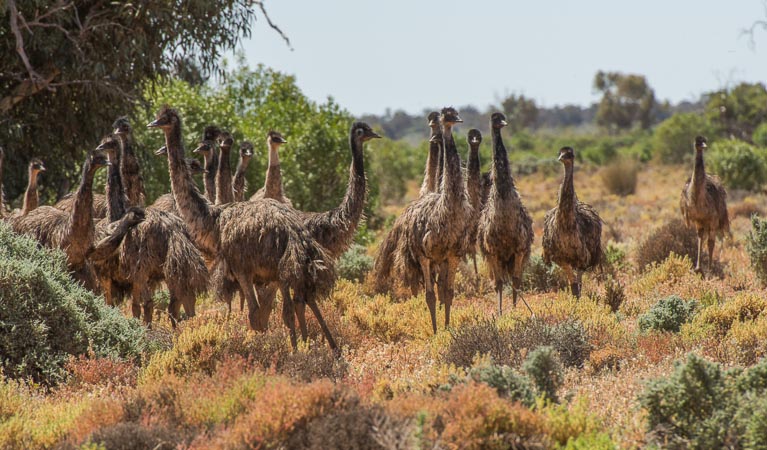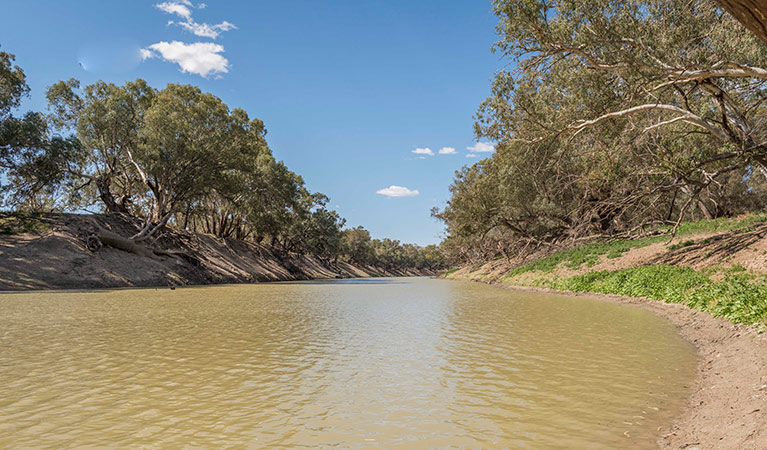Learn more
Learn more about why this park is special
Peery Lake picnic area is in Paroo-Darling National Park. Here are just some of the reasons why this park is special:
A unique and diverse ecosystem

The Paroo Overflow and its associated wetlands sustain a unique ecosystem, including such threatened species as the freckled duck and blue-billed duck. You may also see black-breasted buzzards, pink cockatoos, pied honeyeaters and any one of 55 bird species that visit the lakes. Peery Lake, a major part of the system, is part of an internationally significant wetland and protected under the Ramsar Convention.
Aboriginal heritage

The Paakantyi and Ngiyeempaa People have traditionally made this area their home. The park is a historically and culturally important site: with its hearths, quarries and specialised microblade occupation sites, the area provides significant information about changing technologies and ways of life over the last 10,000 years.
European history

Pastoralists were also attracted to the banks of the Darling River. As well as water, it provided a major transport corridor. Riverboats began navigating the system in the 1850s, and Cobb and Co also ran several routes through this important pastoral region.
- Darling River Run tag-along tour Follow the Darling River on a 15-day driving trip with Xpedition Tagalong Tours. Explore the incredible attractions in Outback NSW as you journey from Lightning Ridge through Broken Hill to Wentworth.
Plants and animals protected in this park
Animals
-

Wedge-tailed eagle (Aquila audax)
With a wingspan of up to 2.5m, the wedge-tailed eagle is Australia’s largest bird of prey. These Australian animals are found in woodlands across NSW, and have the ability to soar to heights of over 2km. If you’re bird watching, look out for the distinctive diamond-shaped tail of the eagle.
-

Emu (Dromaius novaehollandiae)
The largest of Australian birds, the emu stands up to 2m high and is the second largest bird in the world, after the ostrich. Emus live in pairs or family groups. The male emu incubates and rears the young, which will stay with the adult emus for up to 2 years.
-

Red kangaroo (Macropus rufus)
The red kangaroo is one of the most iconic Australian animals and the largest marsupial in the world. Large males have reddish fur and can reach a height of 2m, while females are considerably smaller and have blue-grey fur. Red kangaroos are herbivores and mainly eat grass.
Plants
-

Mulga (Acacia aneura)
Mulga are hardy Australian native plants found throughout inland Australia. With an unusually long tap root, the mulga is able to withstand long periods of drought.
-

Saltbush (Atriplex nummularia)
A hardy Australian native plant, the saltbush is a small spreading shrub that can withstand dry salty soils such as those found in the desert plains of western NSW. It is grey-white in colour and has small spear-shaped succulent leaves. It flowers from December to April.
Look out for...
Red kangaroo
Macropus rufus

The red kangaroo is one of the most iconic Australian animals and the largest marsupial in the world. Large males have reddish fur and can reach a height of 2m, while females are considerably smaller and have blue-grey fur. Red kangaroos are herbivores and mainly eat grass.
